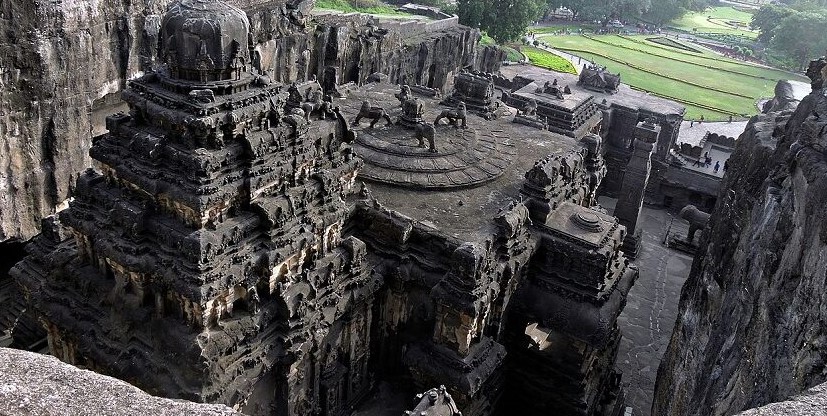The Kailash Temple at Ellora Caves – Conspiracy Theories about approx. 1300 years old Architectural Marvel
The Kailash Temple – The Bizarre Theories about approx. 1300 years old Caves.
The Kailash Temple, located within the Ellora Caves in Maharashtra, India, is one of the most remarkable architectural feats of ancient India. Carved out of a single rock, it is renowned for its grandeur and intricate design. However, its construction has given rise to a plethora of bizarre theories that challenge our understanding of ancient engineering and craftsmanship. This exploration delves into these theories, examining their origins and implications.
Extra-terrestrial Influence
One of the most sensational theories surrounding the Kailash Temple is the idea that it was constructed with the assistance of extra-terrestrial beings. Proponents of this theory argue that the sheer scale and precision of the temple’s carvings are beyond what could be achieved by human artisans using primitive tools. The temple, completed in less than 18 years, involved the removal of approximately 400,000 tons of rock. This feat raises questions about how such a massive project could be accomplished without advanced technology.
Supporters of the alien theory point to the temple’s unique architectural features, such as its vertical rock-cut architecture and intricate sculptures that some interpret as representations of advanced technology or even spacecraft. They suggest that these characteristics indicate knowledge or skills that were not available to humans at the time, thus implying an otherworldly influence.
Advanced Ancient Technology
Another theory posits that ancient builders possessed lost technologies or methods that have since been forgotten. Some researchers speculate that the craftsmen used advanced techniques involving heat or water erosion to carve the temple’s intricate details. This theory challenges conventional narratives about ancient construction methods, suggesting that there may have been more sophisticated tools or techniques in use than previously acknowledged.
The absence of scaffolding during construction further fuels speculation about how the builders managed to create such a massive structure from top to bottom without modern machinery. The idea that they could achieve this with only hammers and chisels has led some to theorize about potential forgotten technologies or even divine intervention.
The Legend of King Krishna-I
According to local folklore, King Krishna I commissioned the temple in fulfilment of a vow made by his queen. As the story goes, she promised to build a grand temple for Lord Shiva if her husband recovered from a serious illness. To expedite construction, an architect named Kokas proposed a top-down approach, allowing them to complete the temple’s shikhara (spire) first, thus fulfilling her vow without compromising on time.
While this tale adds a layer of intrigue to the temple’s history, it also raises questions about the actual methods used in its construction. The notion that such an ambitious project was driven by personal devotion rather than practical planning leads some theorists to speculate about hidden motives or deeper spiritual significance behind its creation.
Unusual Alignments and Acoustic Phenomena
The orientation of the Kailash Temple is another point of contention among theorists. Unlike most Hindu temples that typically face east or north, Kailash faces west. This unusual alignment has led some to speculate about its astrological or spiritual significance. Additionally, visitors often report experiencing strange acoustic properties within the temple, with sounds echoing in unexpected ways. Some suggest these phenomena were intentionally designed for ceremonial purposes or spiritual experiences.
Hidden Passages and Secret Rituals
Within the Kailash Temple complex are several hidden passages and chambers whose purposes remain largely speculative. Some theorists believe these areas may have been used for secret rituals or as escape routes during invasions. The existence of these concealed spaces adds an air of mystery to the temple and invites further exploration into its historical context.
Failed Destruction Attempts
The resilience of the Kailash Temple is notable; it has withstood numerous attempts at destruction throughout history. During his reign, Mughal Emperor Aurangzeb ordered efforts to dismantle it, employing over 1,000 workers for three years without success—aside from damaging some sculptures. This failure has led some to believe that there are mystical properties associated with the temple that protect it from destruction.
Symbolism and Artistic Interpretation
The intricate sculptures adorning the temple depict various deities and mythological scenes, leading some theorists to interpret them as symbols of advanced knowledge or extra-terrestrial contact. The level of detail and artistry displayed in these carvings raises questions about their intended meanings and whether they were meant to convey messages beyond religious devotion.
The Kailash Temple at Ellora stands as a testament to ancient craftsmanship and architectural ingenuity. However, its construction has given rise to numerous bizarre theories ranging from extra-terrestrial involvement to lost technologies and hidden rituals. While these theories may capture public imagination, they also reflect broader questions about our understanding of history and human capability.
Legacy of the Kailash Temple at Ellora Caves
As scholars continue to study this remarkable structure, it remains an enduring symbol of mystery and wonder a place where spirituality meets artistry amid unanswered questions about its origins and purpose. Whether viewed through a lens of skepticism or belief in the extraordinary, the Kailash Temple continues to inspire awe and intrigue among visitors from around the world.
Also Read-
Rocking Star Yash: A Journey of Stardom and Triumph on His Birthday
